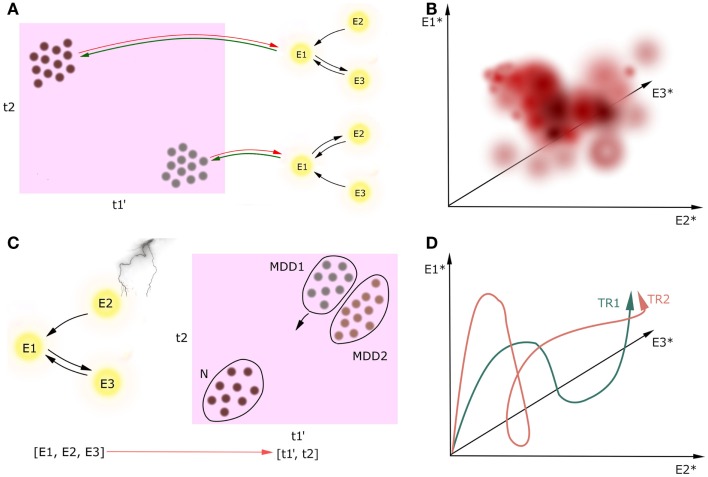Figure 3.
Circuit to construct mapping. Causality between activity in underlying network (nodes E1, E2, E3) and the multidimensional construct space (t1, t2) can go two ways, but we are only interested in neural circuitry as the cause and cognitive constructs as the effect [(A), green lines]. Behavioral learning and neuroplasticity can give the backward direction of causality [(A), red lines]; however, we do not cover this issue in this paper. We refer to cognitive constructs as ti because the preliminary step of the CCM includes determining the full list of the involved constructs which can be broader than the list of the DSM-5 diagnostic criteria. Prime denotes endophenotype, dot denotes a patient, asterisk denotes attractor state. Firstly, circuitries involved in these constructs should be linked on the basis of extensive observational research on a large cohort of patients (A). Secondly, we can plot how these attractors map onto cognitive constructs with temperature maps (B). In this example, we plot the value of one continuous construct (which can represent, i.e., level of mood) in a three-dimensional space spanned by the attractors of the underlying three-node network. Thirdly, one can track the current state of one patient both in the multidimensional construct space during the treatment [(C), a scatter plot in case we want to track multiple patients at a time]. Distribution of patients in this space may reveal subtypes of MDD (MDD1, MDD2). Moreover, when the network manipulation with treatment is sufficient, it can trigger the patient’s brain state toward a new attractor in some of the construct-related dimensions, and in a result the patient flows to another point in the construct space. Since we will create these maps on the data from the limited number of patients in the cohort, this temperature maps will not span the whole volume of possibilities. Lastly, one may investigate how the treatments TRi affect the attractors of the underlying networks (D). In this case, we have three nodes in the underlying networks, which means that the attractors of this system will be points in a three-dimensional attractor space.

